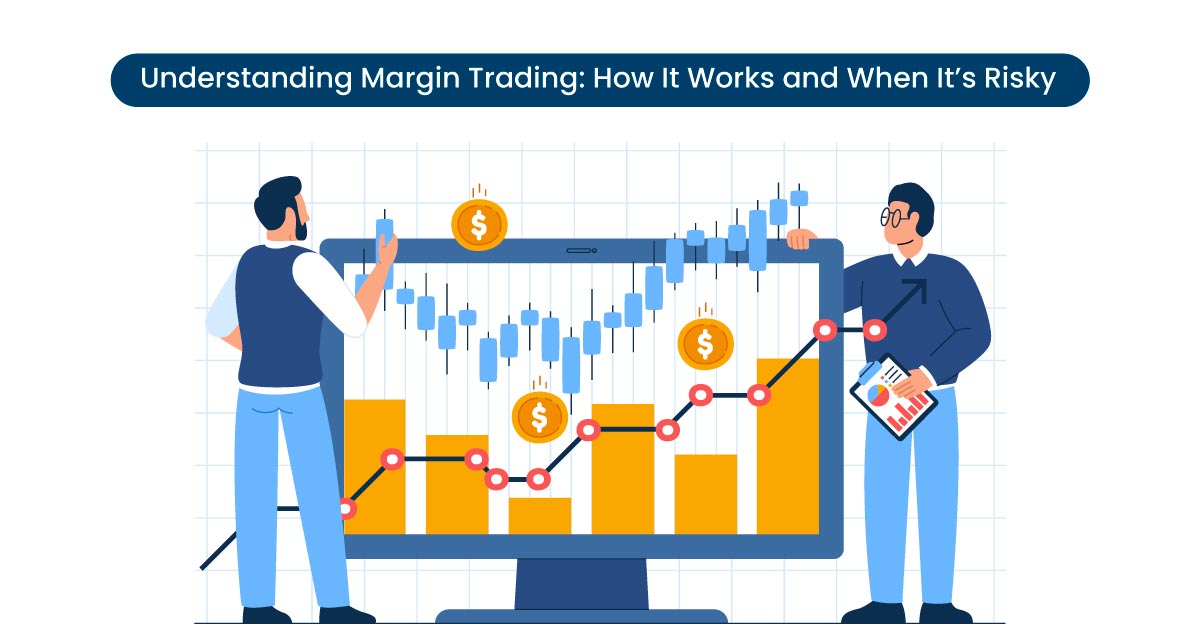Margin trading is a trading strategy that allows investors to borrow money from their broker to purchase securities. By using borrowed funds, investors can leverage their investments, potentially amplifying both profits and losses.

How Does Margin Trading Work?
To understand margin trading, let's consider a simple example:
Suppose you have ₹10,000 in your brokerage account. With a 1:2 margin, your broker will lend you an additional ₹10,000, giving you a total of ₹20,000 to invest. If you use this money to buy shares, a small price movement can lead to significant gains or losses.
The Mechanics of Margin Trading
1.Margin Account: You open a margin account with your broker.
2.Margin Requirement: Your broker will set a margin requirement, which is the percentage of the total value of the securities you must fund with your own money.
3.Leverage: The leverage ratio is the amount of borrowed funds relative to your investment.
4.Interest Charges: Interest will be applied to the money you borrowed.
5.Maintenance Margin: Your broker will set a maintenance margin, which is the minimum amount of equity you must maintain in your margin account. If your account falls below the maintenance margin, you'll receive a margin call, requiring you to deposit additional funds to meet the margin requirement.
The Benefits of Margin Trading
● Amplified Returns: Margin trading allows you to potentially earn higher returns on your investments.
● Increased Buying Power:You can buy more shares with a smaller initial investment.
● Tax Efficiency: In some cases, margin interest may be tax-deductible.
The Risks of Margin Trading
● Margin Calls: If your account value falls below the maintenance margin, you'll receive a margin call, forcing you to deposit additional funds.
● Increased Risk Tolerance: Margin trading can lead to increased risk-taking behavior, which can be detrimental to your overall financial health.
● Interest Costs: You'll need to pay interest on the borrowed funds, which can erode your profits.
When to Consider Margin Trading
Margin trading is not suitable for all investors. It's generally recommended for experienced investors with a strong risk tolerance.
● You have a solid understanding of the market: A deep understanding of market dynamics is crucial for successful margin trading.
● You have a strong risk tolerance: Margin trading involves significant risk, so it's important to be comfortable with potential losses.
● You have a well-defined investment strategy: A clear investment strategy can help you make informed decisions and manage risk effectively.
How to Get Started with Margin Trading
1.Open a Margin Account: Open a margin account with a reputable broker.
2.Meet the Margin Requirements: Ensure you have sufficient funds to meet the initial margin requirement.
3.Understand the Risks: Learn about the dangers that come with trading on margin.
4.Develop a Trading Plan: Create a well-defined trading plan, including your investment goals, risk tolerance, and exit strategies.
5.Monitor Your Account Closely: Keep a close eye on your account balance and margin levels.
Best Practices for Margin Trading
● Start Small: Begin with a small amount of leverage to minimize risk.
● Diversify Your Portfolio: To lower risk, distribute your investments among several asset groups.
● Avoid Emotional Decision-Making: Make rational, data-driven decisions.
The Role of Technology in Margin Trading
Technology has revolutionized the way we trade stocks. Best stock trading platforms offer advanced features that make margin trading more accessible and efficient. These platforms provide real-time market data, charting tools, and automated trading tools to help investors make informed decisions.
Share Market
Understanding share market where investors buy and sell shares of publicly traded companies. By investing in stocks, you become a part-owner of a company and can potentially earn returns through capital appreciation and dividends.

How to Invest in Stocks
To invest in stocks, you need to follow these steps:
1.Open a Demat Account: A Demat account is a digital account where your shares are held electronically.
2.Open a Trading Account: Buying and selling shares is possible with a trading account.
3.Choose a Broker: Select a reliable broker to execute your trades.
4.Research Stocks: Conduct thorough research on the companies you want to invest in.
5.Place Orders: Use your trading account to place buy or sell orders for the desired stocks or in a simple way it is to buy stocks online.
The Psychology of Margin Trading
Understanding the psychology of margin trading is crucial for investors. It can lead to both significant profits and substantial losses, depending on how it's used.
Common Psychological Biases in Margin Trading:
● Overconfidence: Overconfidence can lead to excessive risk-taking, as investors may overestimate their ability to predict market movements.
● Fear of Missing Out (FOMO):FOMO can drive investors to take on excessive risk, leading to impulsive decisions.
● Loss Aversion: Investors may be more inclined to hold onto losing positions, hoping for a recovery, rather than cutting their losses.
● Confirmation Bias: Investors may selectively seek information that confirms their existing beliefs, ignoring contrary evidence.
Managing Psychological Biases
To mitigate the impact of psychological biases, consider the following strategies:
● Develop a Trading Plan: You may maintain discipline and steer clear of rash decisions by having a clear trading plan.
● Set Stop-Loss Orders: Stop-loss orders can help limit potential losses.
● Take Regular Breaks: Stepping away from the market can help you avoid emotional decision-making.
● Seek Professional Advice: A financial advisor can provide objective advice and help you stay disciplined.
● Practice Mindfulness: Mindfulness techniques, such as meditation, can help you stay calm and focused.
The Future of Margin Trading
As technology continues to advance, the future of margin trading looks promising. Advanced trading platforms and AI-powered tools can help investors make more informed decisions and manage risk more effectively.
However, it's important to remember that margin trading is a complex and risky strategy. It's crucial to use it responsibly and to be aware of the potential pitfalls.
The Regulatory Landscape of Margin Trading
Margin trading is subject to various regulations and oversight by regulatory authorities. These regulations are designed to protect investors and maintain market integrity.
Key Regulatory Considerations:
● Margin Requirements: Regulatory authorities set minimum margin requirements, which determine the amount of equity investors must maintain in their margin accounts.
● Interest Rates: Interest rates on margin loans are regulated, and brokers are required to disclose these rates to their clients.
● Disclosure Requirements: Brokers must disclose the risks associated with margin trading and provide clear information about margin requirements, interest rates, and fees.
● Risk Management: Brokers are required to implement risk management practices to monitor their clients' margin accounts and take appropriate action to mitigate risk.
The Impact of Regulatory Changes on Margin Trading
Changes in regulations can significantly impact the availability and cost of margin trading. For example, increased regulatory scrutiny can lead to stricter margin requirements and higher interest rates.
Conclusion:
Margin trading can be a powerful tool for experienced investors to amplify their returns. However, it's essential to understand the risks involved and use it responsibly. By following best practices and managing risk effectively, you can potentially benefit from margin trading. Remember, always conduct thorough research and consult with a financial advisor before making any investment decisions.




.png)